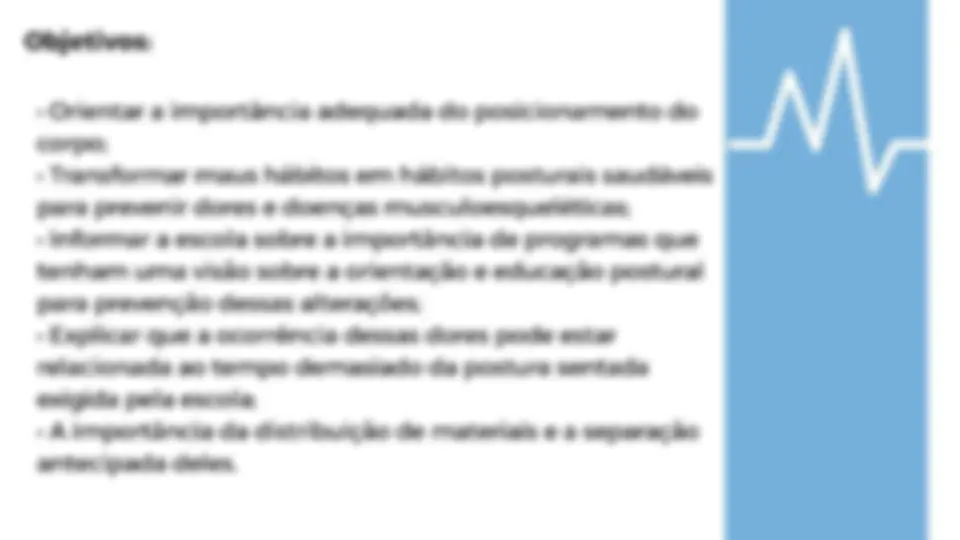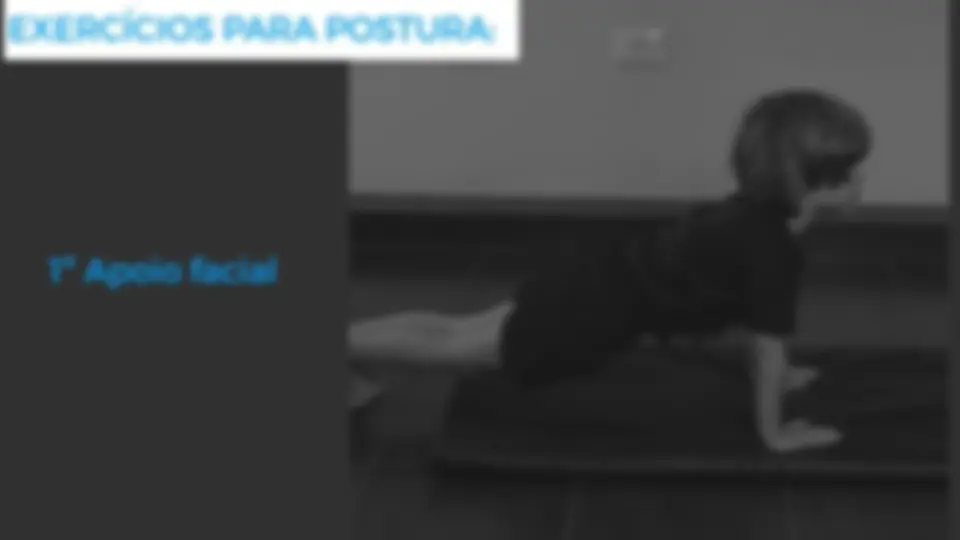Pré-visualização parcial do texto
Baixe Afecções nas costas: a importância de uma abordagem preventiva em escolares e outras Slides em PDF para Fisioterapia, somente na Docsity!
DISCENTES: CATARINA GOMES DE o. FREITAS; JOÃO PAULO N. DE OLIVEIRA; JOÃO PAULO CARDOSO DE L. NUNES; MAYCK SOARES DE ARAÚJO; STEFANNY MIRLA DE ALENCAR M. CARVALHO. Global, regional, and national disability-adjusted life-years (DALYs) for 359 diseases and injuries and healthy life expectancy (HALE) for 195 countries and territories, 1990-2017: a systematic analysis for the Global Burden of Disease Study 2017 ummary ackground How long one lives, how many years of life are spent in good and poor health, and how the population's state of health and leading causes of disability change over time all have implications for policy, planning, and provision of services. We comparatively assessed the patterns and trends of healthy life expectancy (FALE), which quantifies the number of years of life expected to be lived in good health, and the complementary measure of disability-adjusted life- years (DALYs), a composite measure of disease burden capturing both premature mortality and prevalence and severi of ill health, for 359 discases and injuries for 195 countries and territories over the past 28 years. Methods We used data for age-specific mortality rates, years of life lost (YLLs) due to premature mortality, and years lived with disability (YLDs) from the Global Burden of Diseases, Injuries, and Risk Factors Study (GBD) 2017 to calculate HALE and DALYs from 1990 to 2017. We calculated HALE using age-specific mortality rates and YLDs per capita for each location, age, sex, and year. We calculated DALYs for 359 causes as the sum of YLLs and YLDs. We assessed how observed HALE and DAIYs differed by country and sex from expected trends based on Socio- demographic Index (SDI). We also analysed HALE by decomposing years of life gained into years spent in good health and in poor health, between 1990 and 2017, and extra years lived by females compared with males, Findings Globally, from 1990 to 2017, life expectancy at birth increased by 7-4 years (95% uncertainty interval 7-1-7 -8), from 65-6 years (65-3-65 8) in 1990 to 73-0 years (72-7-73-3) in 2017. The increase in years oflife varied from 5 -1 years (5-0-5:3) in high SDI countries to 12.0 years (11-3-12-8) in low SDI countries. Of the additional years of life expected at birth, 26-3% (20-1-33-1) were expected to be spent in poor health in high SDI countries compared with 11-7% (8-8-15-1) in low-middle SDI countries. HALE at birth increased by 6-3 years (5-9-6-7), from 57-0 years (54-6-59-1) in 1990 to 633 years (60-5-65-7) in 2017. The increase varied from 3-8 years (3-4-4-1) in high SDI countries to 10-5 years (9-8-11-2) in low SDI countries. Even larger variations in HALE than these were observed between countries, ranging from 1-0 year (0-4-1.7) in Saint Vincent and the Grenadines (62-4 years [59-9-64-7] in 1990 to 63-5 years [60-9-65-8] in 2017) to 23:7 years (21-9-25-6) in Eritrea (30-7 years [28-9-32-2] in 1990 to 54-4 years [51-5-57-1] in 2017). In most countries, the increase in HALE was smaller than the increase in overall life expectancy, indicating more years lived in poor health. In 180 of 195 countries and territories, females were expected to live longer than males in 2017, with extra years lived varying from 1.4 years (0-6-2-3) in Algeria to 11.9 years (10-9-12.9) in Ukraine. Of the extra years gained, the proportion spent in poor health varied largely across countries, with less than 20% of additional years spentin poor health in Bosnia and Herzegovina, Burundi, and Slovakia, whereas in Bahrain all the extra years were spent in poor health. In 2017, the highest estimate of HALE at birth was in Singapore for both females (75-8 years [72-4-78-7]) and males (72.6 years [69-8-75-0) and the lowest estimates were in Central African Republic (47-0 years [43-7-50--2] for females and 42-8 years [40-1-45-6] for males). Globally, in 2017, the five leading causes of DALYs were neonatal disorders, ischaemic heart disease, stroke, lower respiratory infections, and chronic obstructive pulmonary Between: 1990 and 2017, age-standardised DALY rates decreased by 41-3% (38-8-43-5) for communicable and by 49-8% (47-9-51.6) for neonatal disorders. For non-communicable diseases, global DALYs increased by 40-19 (36-8-43-0), although age-standardised DALY rates decreased by 18-1% (16-0-20-2). Interpretation With increasing life expectancy in most countries, the question of whether the additional years of life gained are spent in good health or poor health has been increasingly relevant because of the potential policy such as health-care provisions and extending retirement ages. In some locations, à large proportion of those additional years are spent in poor health. Large inequalities in HALE and disease burden exist across countries in different SDI quintiles and between sexes. The burden of disabling conditions has serious implications for health system planning and health-related expenditures. Despite the progress made in reducing the burden of communicable diseases and neonatal disorders in low SDI countries, the speed of this progress could be increased by scaling up This one publcationhas been. corected The corected version first appeared atthelancet.com onjune20,2019 colaborar ProfChistopher L Mura elmewedo CONDUTA IDEAL 1: Âmbito preventivo educacional 3: Tratamento 2: Detecção precoce Objetivos: * Orientar a importância adequada do posicionamento do corpo; * Transformar maus hábitos em hábitos posturais saudáveis para prevenir dores e doenças musculoesqueléticas; * Informar a escola sobre a importância de programas que tenham uma visão sobre a orientação e educação postural para prevenção dessas alterações; * Explicar que a ocorrência dessas dores pode estar relacionada ao tempo demasiado da postura sentada exigida pela escola; * À importância da distribuição de materiais e a separação antecipada deles. ADO CORRETO O que as mochilas pesadas estão fazendo com o corpo das crianças Cerca de 5 000 crianças vão parar no pronto-socorro todo ano por causa de lesões ligadas a mochilas, 14 000 crianç ecebem tratamento por e: O. Nem todas as criam: para oh ausa do peso das mochilas, mas o sobrepeso pode provocar d no pescoço, nas costas e nos ombros — e mais. Veja abaixo por que é tão perigoso carregar mochilas pesadas — e o que os pais podem fazer a respeito e pelo menos ital por Pescoço e parte superior das costas Postura com Postura a» cabeça correta ú inclinada para a frente Próximas do corpo. A a starbem = Ombros r Apoio extra Use ambos os ombros. A Peso Distribuição. Use Proporção. As mc 1º Apoio facial 2º Apoio dorsal 4º Posição da vela CONCLUSÃO Podemos concluir que a abordagem de programas preventivos e educativos sobre a postura corporal é de suma importância para a promoção de saúde e melhora da qualidade de vida da comunidade escolar. Também é importante ressaltar o papel dos pais ou responsáveis, professores e demais profissionais que trabalham em âmbito escolar, os quais devem estar cientes sobre a importância de se manter em vigilância os hábitos posturais das crianças, a fim de se evitarem deformidades permanentes e demais afecções, que, muitas vezes, são acompanhadas de algias na vida adulta. REFERÊNCIAS BRACCIALLI, L.; R. ASPECTOS A SEREM CONSIDERADOS NA ELABORAÇÃO DE PROGRAMAS DE PREVENÇÃO E ORIENTAÇÃO DE PROBLEMAS POSTURAIS. Re N.4, P16-28, JAN./JUN. 2000. CANDIOTTI, C.T. ET AL EDUCAÇÃO POSTURAL COMO CONTEÚDO CURRICULAR DA EDUCAÇÃO FÍSICA NO ENSINO FUNDAMENTAL NAS ESCOLAS DA CIDADE DE MONTENEGRO/RS. REV. MOV PORTO ALEGRE, V. 3, N. 17, P.57-77, 2011. EITNER, D; KUPRIAN, W.; MEISSNER, L. ET AL. FISIOTERAPIA NOS ESPORTES. SÃO PAULO: MANOLE, 1984. GRIVAS, T. B. ET AL. DOCUMENTO DE CONCENSO SOSORT: TRIAGEM ESCOLAR PARA ESCOLIOSE. ONDE ESTAMOS HOJE? ESCOLIOSE. [S.L.], N. 2, P.1, 2007. DISPONÍVEL EM: HTTP:/ANWW.SCOLIOSISJOURNAL.COM/CONTENT/2/1/17. ACESSO EM: 26/11/2007. HOY, B. ET AL. BUCHVINDER, R. THE GLOBAL BURDEN OF NECK PAIN: ESTIMATES FROM THE GLOBAL BURDEN OF DISEASE 2010 STUDY. ANN RHEUM DIS, 2014. HAY, S. 1. ET AL. GLOBAL, REGIONAL, AND NATIONAL DISABILITY-ADJUSTED LIFE-VEARS (DALYS) FOR 333 DISEASES AND INJURIES AND HEALTHY LIFE EXPECTANCY (HALE) FOR 195 COUNTRIES AND TERRITORIES, 1990-2016: A SYSTEMATIC ANALYSIS FOR THE GLOBAL BURDEN OF. DISEASE STUDY 2016. REV. THE LANCET, V. 390, N. 10100, P. 1260-1344, 2017. INSTITUTO BRASILEIRO DE GEOGRAFIA E ESTATÍSTICA. PESQUISA NACIONAL POR AMOSTRA DE DOMICÍLIOS. UM PANORAMA DA SAÚDE NO BRASIL: ACESSO E UTILIZA a pd ca di Co A pd 2010. DISPONÍVEL EM: HTTPS;/NNWW .IBGE.GOV. ACESSO EM: 15/04/20. JASSI, F.J.; PASTRE, C.M. ALTERAÇÕES POSTURAIS NA COLUNA VERTEBRAL EM ESCOLARES DO ENSINO FUNDAMENTAL DA CIDADE DE ADAMANTINA-SP. TRABALHO DE CONCLUSÃO DE CURSO (GRADUAÇÃO EM FISIOTERAPIA) - FACULDADES ADAMANTINENSES INTEGRADAS, ADAMANTINA-SP, 2004, KAVALCO, T.F. A MANIFESTAÇÃO DE ALTERAÇÕES POSTURAIS EM CRIANÇAS DE PRIMEIRA A QUARTA SÉRIES DO ENSINO FUNDAMENTAL E SUA RELAÇÃO COMA ERGONOMIA ESCOLAR. REVISTA BRASILEIRA DE FISIOTERAPIA, V. 4, N. 2, 2000. MENOTTI, 3.4. da educação evitando situações que possam afetar a saúde de crianças e adolescentes em idade escolar. R. Perspect. Ci. e den rg Ea MWAKA, E.S. et al. Dor musculoesquelética e uso de mochilas escolares: um estudo transversal entre alunos ugandenses. BMC Res Notes. v.7, p. 222, 2014. MINANA-SIGNES, V.; MONFORT-PANEGO, M. Know ledge on heal thand back care education related to physical activity and exercise in adolescents. European Spine Journal, [SA],v. 25,n.3, p. 755-759,18 abr. 2015. Springer Science and Business Media LLC. NOONE, G: MAZUMDAR, 3; GHISTA, DN; TANSLEY, G.D. Asymmetric al loadsand lateral bending of the human spine. Medical & biological engineering & computing, v31, p. 6-131, 1995. RAI A, AGARAWA, S. Problemas nas costas devido a mochilas pesadas em crianças em idade escolar. IOSR 3 Hum Soc Sci, n.10, p:-5, 2013. SILVA, 3. A. M. Métodos de avaliação clínica e funcional em fisioterapia. Rio de Janeiro (RJ) Guanabara Koogan, 2006. = ,M.A.G.da.Tratare prevenir a dor nas costas: será possível? Rev. Fisioterapia Brasil, [S.l.], v. 2, n. 4, p. 203 - 204, dez. 2016. ISSN 2526-9747. L.R.daetal. Alterações posturais em crianças e adolescentes obesos e não-obesos. Rev. bras. cineantropom. Desempenho hum TOniina), Florianópolis: 15 1.6 p. 6468-454, 2011 SAMPAIO, M. H. L. de M. et al. Alterações posturais e dor no desempenho acadêmico de escolares do ensino fundamental. Rev.Fisioter. mov. v.29, n.2, 2016. —— , CN. etal. Avaliação biomecânica de parâmetros antropométricos e dinâmicos durante a marcha em crianças obesas. Anais do Vil Congresso Brasileiro de Biomecânica, p. 447-52, 1997. SANTOS, CLS. et al. Ocorrência de desvios em escolares do ensino público fundamental de FR o o TENERALA demo mano na E CUANDO NO pa a DD VERDERI, E. A importância da avaliação postural na fase do estirão do crescimento. Disponível em: https://siteantigo.portaleducacao.com.br/conteudo/artigos/fisioterapia/a -importancia-da-avaliacao-postural-na-fase-do-estirao-de-crescimento/58229. Acesso em: 11 de dezembro de 2006. XAVIR, €. A et al. Uma avaliação acerca da incidência de desvios posturais em escolares. Rev Meta: Aval. v.7, n. 3,p.81-94, 2011. 































